Real Racing Club de Santander have been highly entertaining to watch this season. The Segunda Division side have scored 36 goals in 21 league games, two more than their closest competitors (Eibar and Espanyol), while also conceding 29 times — the highest among the top 14 teams in the division.
Their inability to stop letting in goals, despite scoring plenty of their own, means they are only sixth in the Spanish second tier with 33 points, occupying the final promotion play-off spot. They are, however, only six points behind leaders CD Leganes and four adrift of Racing Ferrol, who occupy the other direct promotion spot.
A significant reason for the Montañeses‘ free-flowing attack has been youngster Gerard ‘Peque’ Fernández, who has scored 10 times in 20 Segunda Division matches, amounting to 27.8% of his team’s total output. Peque leads the league in goals alongside Espanyol’s Javi Puado and has turned heads in Spain with his performances.
This scout report and tactical analysis will look at his goalscoring and other attacking attributes, with additional analysis on how he has fitted into Racing’s tactics this season.
Background
Peque, born on October 4, 2002, is a product of Barcelona’s famed La Masia academy but left them in 2016 to join Cornella’s youth team. He went on to play for their U19 team two years later and even made two appearances for their senior squad before returning to Barcelona’s B team, now known as Barca Atletic, in 2019. The Spaniard made 50 appearances for the latter, scoring eight goals and laying out two assists, including one goal in five UEFA Youth League matches.
With a route to the first team looking complicated, Peque left Barca Atletic to join Racing in the summer of 2022. He settled for just 23 appearances during the 2022-23 season, of only five were starts, and scored just once as Racing finished 12th in the Segunda Division with only 54 points from 42 matches. However, he impressed in their final league game of the campaign, assisting twice as they beat Cartagena 3-1.
Peque began the ongoing season as a fixture in Racing’s XI and has started 17 of their 21 league games, coming off the bench in three. The extended run of time on the pitch has led to a positive impact, as he has already hit double digits in goals scored while providing an assist as well.
Profile
Peque provides a unique skill set which allows him to operate across both flanks and down the middle up front. However, Racing manager Jose Alberto Lopez has preferred to use him predominantly as a second striker or the central attacking midfielder in a 4-2-3-1. The 21-year-old has notably scored nine goals in 15 Segunda Division matches when deployed as a second striker.
His heatmap below suggests that he has the freedom to roam into spaces as needed to provide Racing with outlets in their build-up, with most of his activity occurring in central areas of the final third.
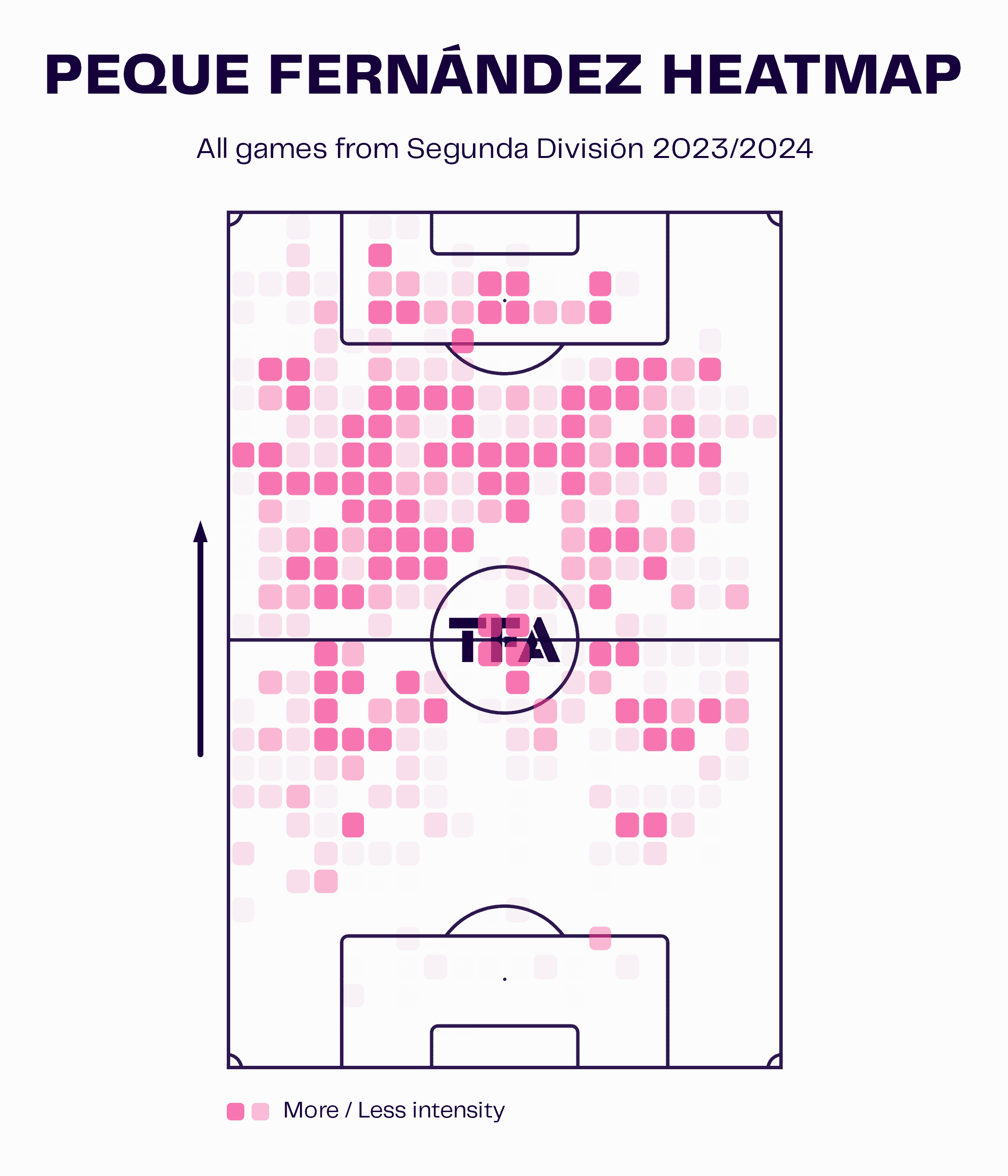
Peque, a right-footed forward, understandably prefers to play on the left, often cutting in to find a teammate with a pass. He averages 0.48 through-balls per 90 in the league this season, which places him in the 91st percentile among his peers. Given his tendency to stay central, his numbers in the crossing and switching of play dimensions are understandably low (0.07 per 90 in both).
Open-play: How Peque’s movement helps shape scoring opportunities
With that out of the way, let’s dive into the most exciting aspect of Peque’s game: his goalscoring!
As you can see in the graph below, the Spaniard’s primary contributions are in attack. He ranks above the 75th percentile in eight of FBRef’s 15 shooting metrics (53.3%), compared to 19 of 87 relevant metrics in passing, creativity and possession (21.8%).
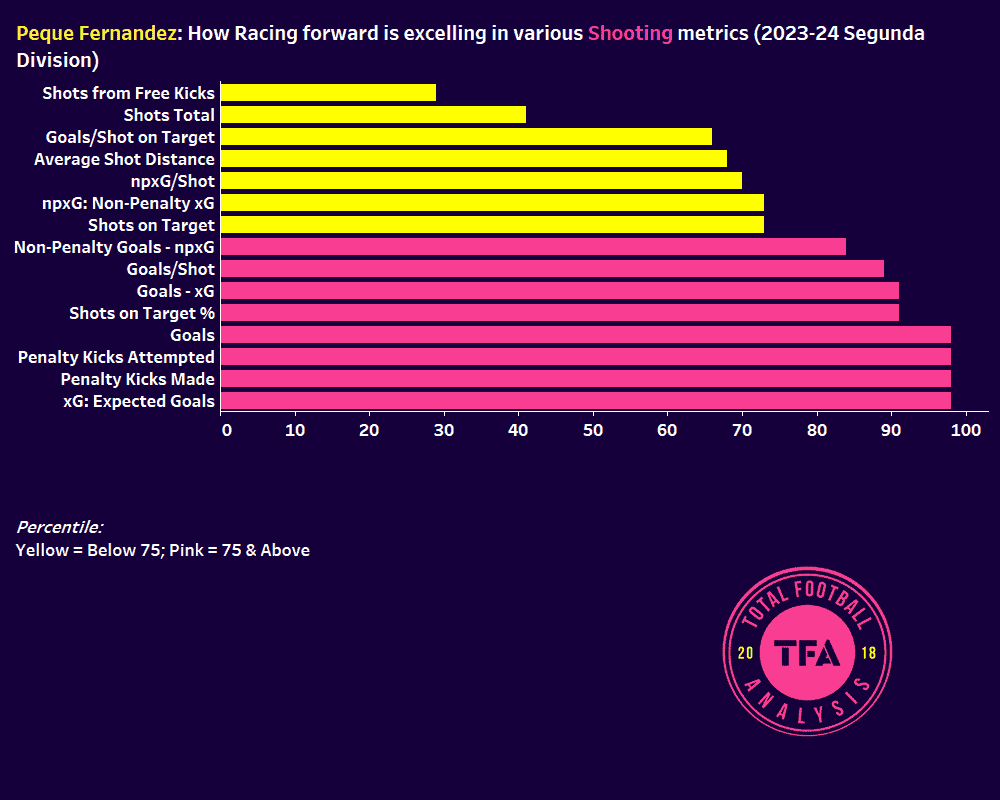
Returning to his goalscoring, Peque has scored five times from open play and five from the penalty spot in the ongoing Segunda Division season. He has scored a brace on three occasions, and each of those has involved a penalty. His non-penalty expected goals (npxG) figure of 0.23 per 90 is almost half of his expected goals (xG) mark of 0.50 per 90. He also has positive figures in the Goals – npxG per 90 (0.12) and Goals – xG (0.19) dimensions.
All of this means that while penalties have certainly boosted his goalscoring record, Peque is not heavily dependent on spot-kicks; the numbers suggest that he has the capacity to be an effective goalscorer regardless. This season, he has averaged only 1.93 shots per 90 but has gotten 46.4% of them on target (91st percentile among peers), which, once again, indicates that he is effective at maximizing his opportunities. A total open-play xG of 4.16 also suggests that he isn’t over-performing and that his current rate of scoring is sustainable over the rest of the season.
As evident from the chart below, most of his shots come from inside the box, where he primarily thrives, with his average shot distance standing at around 16 yards. He has taken only six shots from outside the box, getting only one on target.
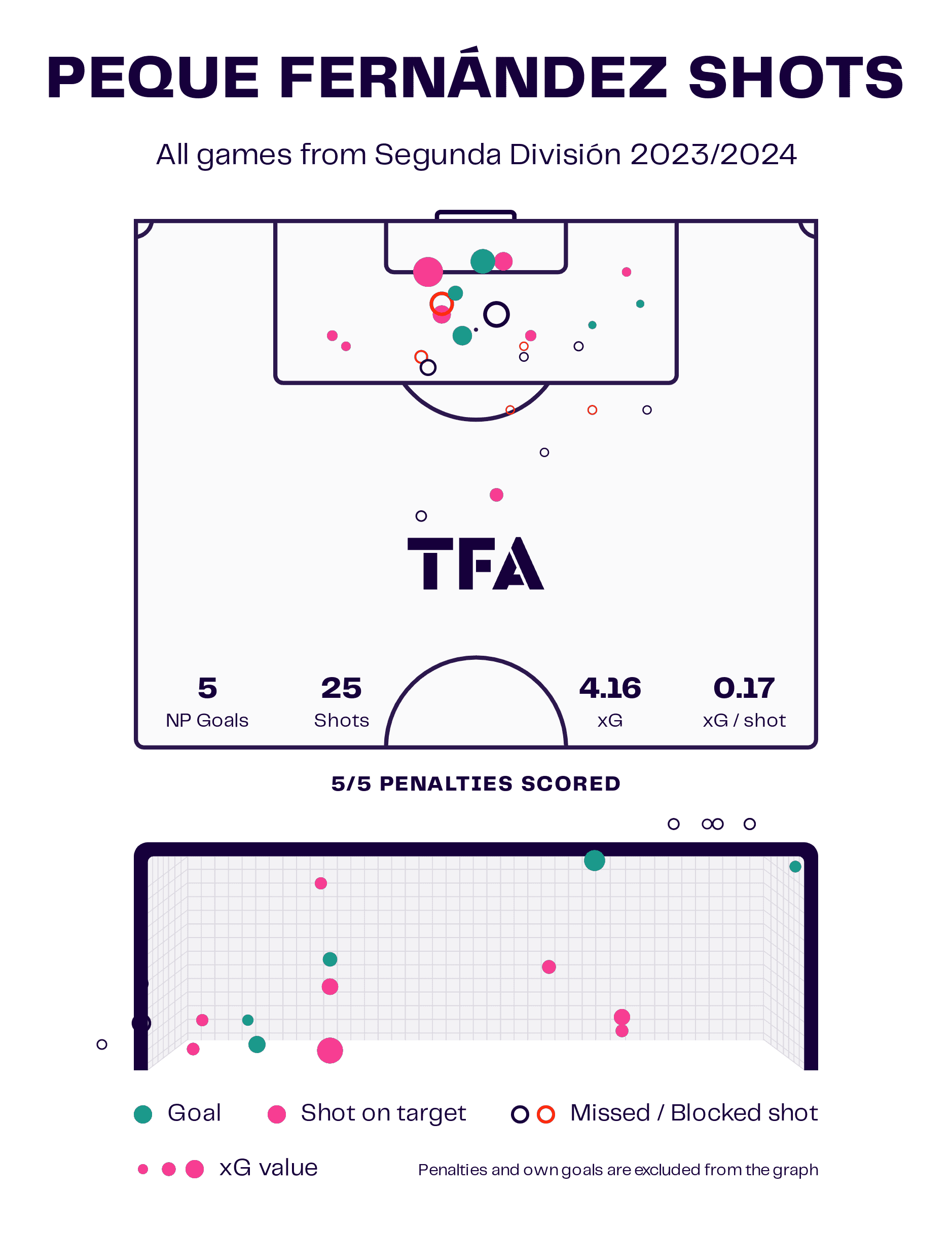
Moving away from the numbers, footage from matches shows that his positioning and off-the-ball movement are also excellent, as they help shape opportunities to score. Consider the following sequence from Racing’s 2-2 draw with Oviedo earlier this month. As his teammate charges forward with the ball, Peque (marked in black) initially asks for a pass on the edge of the area but quickly realizes there is space for the teammate to run to the edge of the area.
He then changes direction, sprints into the right side of the box, and keeps himself onside as Marco Sangalli, who is inside the penalty area from the start, smartly divers the ball towards him. Peque has just enough space to unleash an unchallenged first-time shot with his right foot that zips across the goalkeeper and into the back of the net.
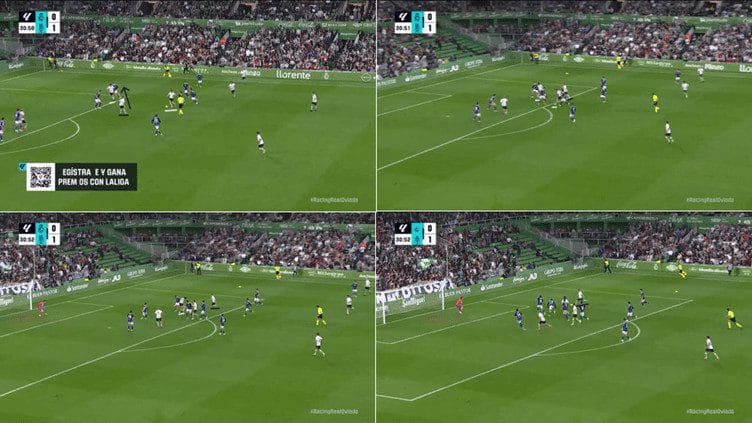
A similar example of Peque’s movement and positioning leading to a goal can be seen in this phase of play from his team’s 3-0 win over Burgos from October. Racing win a free-kick and play it short before midfielder Andres Martin (marked in white) bursts past two defenders to get to the right flank. Peque (marked in black), originally close to the edge of the area, quickly moves in and repositions himself in the space between two defenders (marked in pink), putting him in the perfect position to get a shot away if the opportunity arises.
Martin sends a low cross in, and Peque sticks his right foot out and generates enough power to beat the goalkeeper at his near post. While the finish is good, Martin’s run forward and Peque’s movement to the near-post make this goal possible as Burgos had loaded their box with defenders upon conceding the free-kick.
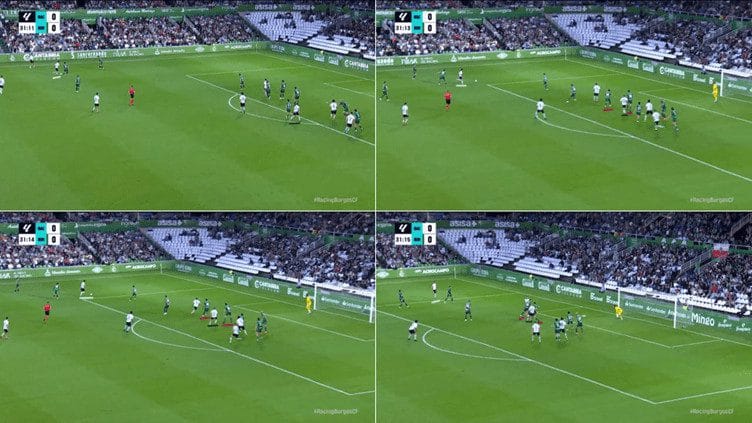
At 5’7″, Peque is not the tallest man going around, and an aerial duel success rate of 38.9% is a testament to that fact. This term, only one of his five open-play goals in the Segunda Division has come via a header. However, a closer look at the goal, which came in a 3-2 win over Cartagena in October, shows that he still has a reasonably powerful header on him.
In this sequence, Peque is once again in a central space on the edge of the area when the move begins but notices that his nearest defender (marked in pink) is almost exclusively focused on the ball (marked in white) and the overlapping Racing player. This means Peque has space between the defenders to run into, and that’s exactly what he does: getting himself into the box.
The cross then comes in via a deflection and lands perfectly on his head but with minimal pace. Peque, however, leaps to thunder a header past the goalkeeper, displaying excellent neck muscle strength to score.

Peque’s penalties: They come in various forms and are hard to stop
Penalty kicks are often scoffed at, with many fans often understating the difficulty of taking a shot from the spot. While it is more likely to go in than most open-play shots, psychological challenges, such as guessing which way the goalkeeper will dive and deciding whether to follow or move away from a recurring pattern, do come up.
One aspect that often helps forwards stay consistent in scoring from the spot is variety. This is undoubtedly one quality Peque has worked on and is displaying on the pitch this season. Be it the standard quick run-up to the spot or the skip-and-score, he has been able to keep the keeper guessing, which has translated into five penalty goals this term.
Here is one example of his spot-kicks from Racing’s 4-0 win over Eibar on Matchday 1 of the season. In this case, Peque first takes a couple of short steps before breaking into a slightly longer stride, gradually picking up pace before reaching maximum momentum when he strikes the ball. It crashes into the top-left corner, beating the goalkeeper, who, to his credit, dives the right away.
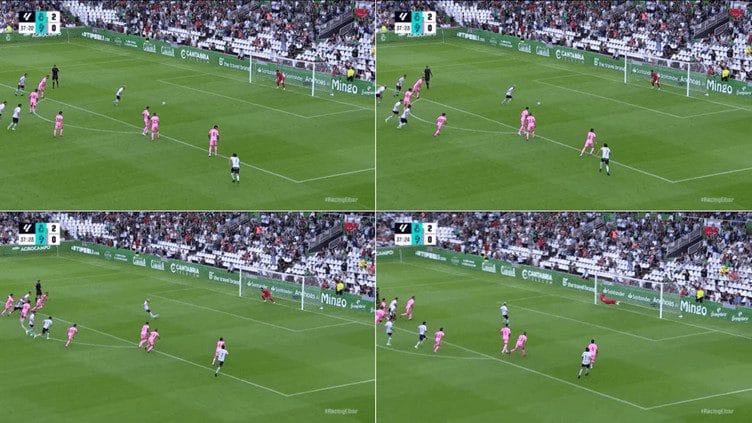
As mentioned earlier, though, Peque can switch things up from the spot, and that’s what he did against Villarreal B in a 2-0 win last month. On this occasion, he starts with a long stride, shifts to shorter steps and then takes one final long stride to plant his left foot near the ball, pausing for a brief second. Once the goalkeeper marginally commits, he gently rolls it into the bottom left corner.
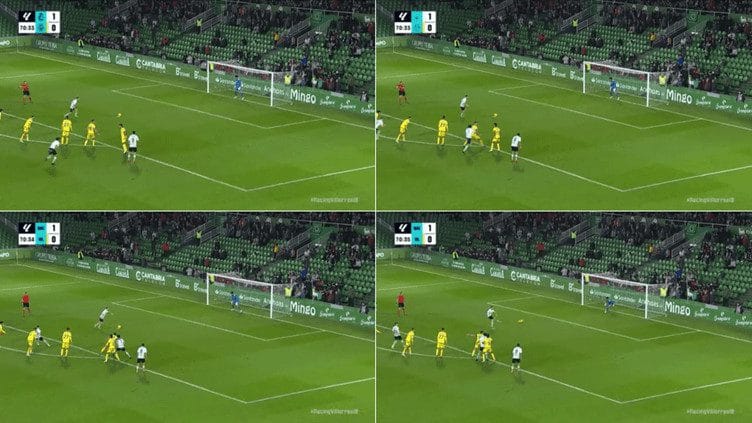
His other three penalties have mostly followed the former approach with no pause. Two of those have found the bottom left corner, with the goalkeeper diving the right way both times but finding himself beaten. The other was guided into the bottom right corner, with the goalkeeper diving the other way.
Passing and Dribbling: Flashes of potential & Room for Growth
As mentioned earlier, most of Peque’s strengths lie in shooting, which is where he has had the most impact for Racing this season. However, as a La Masia student, it’s unsurprising that he has also flashed progression potential at times with his ball-carrying and passing.
This season, Peque has averaged 4.47 attempted take-ons per 90 and has achieved success 58.5% of the time, placing him in the 95th percentile among his peers. Those are incredible numbers, but they are countered by the fact that he is averaging only 27.43 carries per 90, out of which only 0.48 are into the penalty area (38th percentile).
In both sequences below, we can see Peque pick the ball up closer to the halfway line than to the box and then charge forward. In the first case, he is tracked by three Mirandes defenders but leaves two of them behind with his quick feet. The third is retreating, which allows Peque to move into space near the edge of the area. His final pass, though, does not reach its intended target.
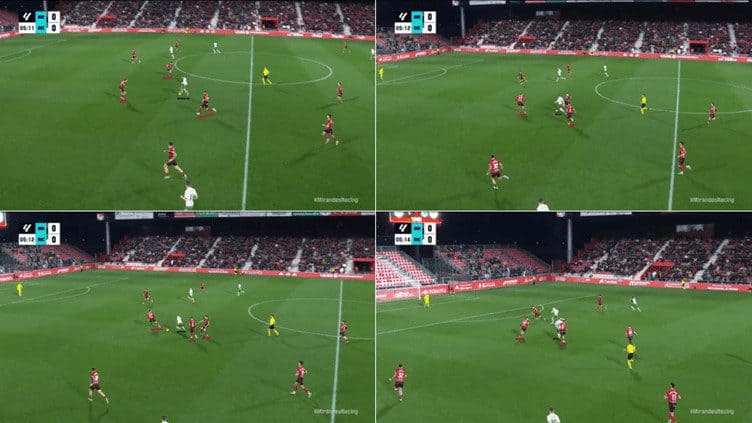
The second situation, from a sequence against Villarreal B, sees him take a quality touch by extending his foot to a pass played slightly ahead of him and cutting in past his marker, opening up a potential opportunity for two of his teammates. However, neither of their runs are central, with both ending up on the right, and he ultimately over-dribbles, allowing the defence to recover and close down some of the gaps.
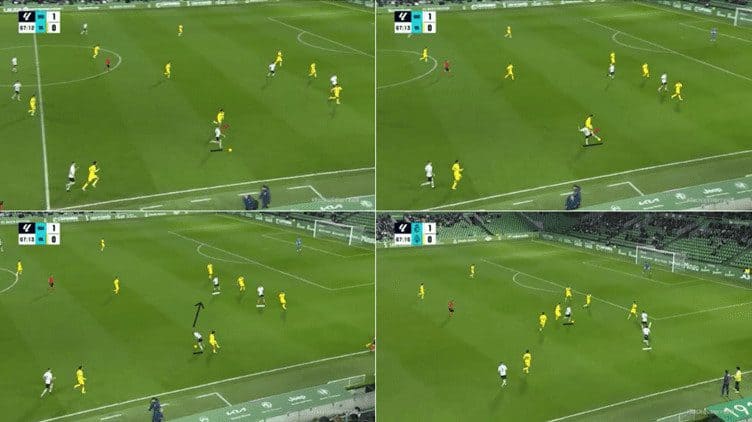
It’s worth noting that Peque somewhat compensates for his lack of penetrating dribbles into the final third through his passing. The youngster has averaged 2.20 passes into the final third, out of which 1.58 are into the penalty area (77th percentile in both). The chances that he succeeds with those passes is decent as his overall passing accuracy is 79.7%, with that percentage rising when we consider only short (88.1%) and medium passes (84.1%). He also averages 0.48 through-balls per 90, placing him in the 91st percentile among his peers.
The effectiveness of his passing in this respect can be seen in the sequence below from Racing’s 3-1 defeat to Alcorcon last month. Here, Peque, surrounded by three defenders, is found by a teammate. He takes a good touch with his left foot to shift the ball to his right before threading the needle to slide a precise pass in an extremely narrow gap between two opposing players to find his teammate on the move in a one-on-one situation. The final shot, however, sails wide.
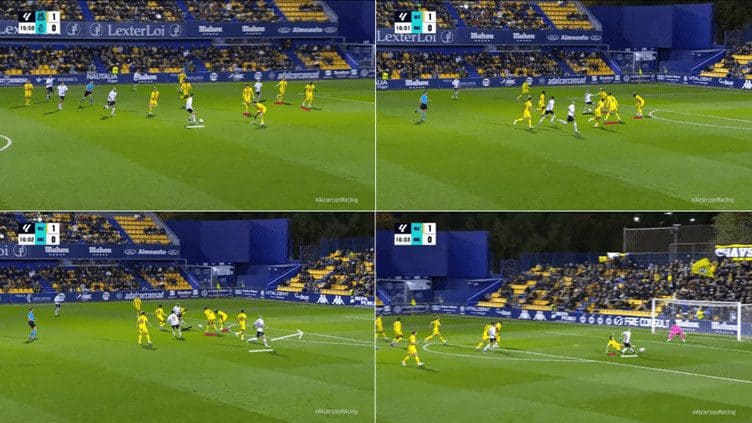
Given his effectiveness in limited space, it is no surprise that Peque can be dangerous when afforded space to manoeuvre. In this play from Racing’s match last week, a 2-0 win over Andorra, he picks the ball up on the left and drives forward, cutting inside his marker to find some space in a more central area. From here, he feeds an excellent through-ball into the box, but his teammate’s first touch takes it wide, and the resulting shot-cum-cross whistles wide of the far post.
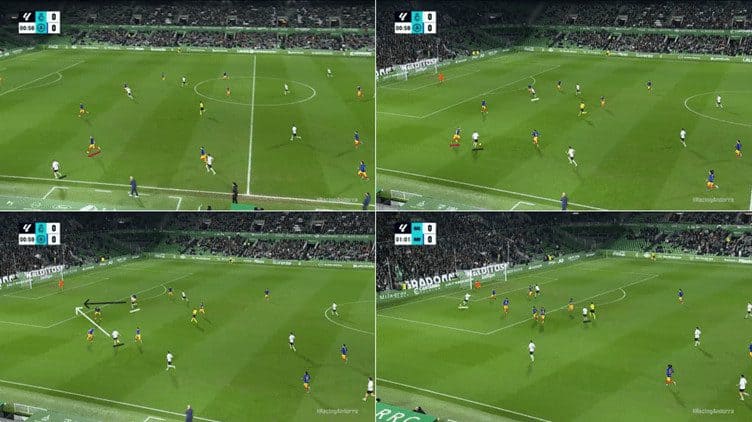
Weaknesses
Peque finds himself in a Racing team that employs a reasonably dynamic set-up, which has led to them scoring aplenty and conceding in copious amounts. His contributions will undoubtedly be key if Racing are to return to La Liga next season, but there are understandably areas in his game that require improvement.
As explained earlier, he can be braver when it comes to carrying the ball forward. Peque also receives only 32.52 passes per 90 in the league. That is not entirely down to him, and we know he can be a force in the final third, but it does raise questions about his positioning during build-up play.
He also commits a high number of fouls per 90 (1.58; Mirandes’ Ilyas Chaira leads this list with 2.09), and given his activity is mainly in the higher middle and attacking third, this has at times led to a break in the team’s flow. Conversely, the Spaniard draws 3.03 fouls per 90, placing him in the 95th percentile; however, the areas he wins these in, as explained in the map below, are not close enough to the box to create a significant enough impact.
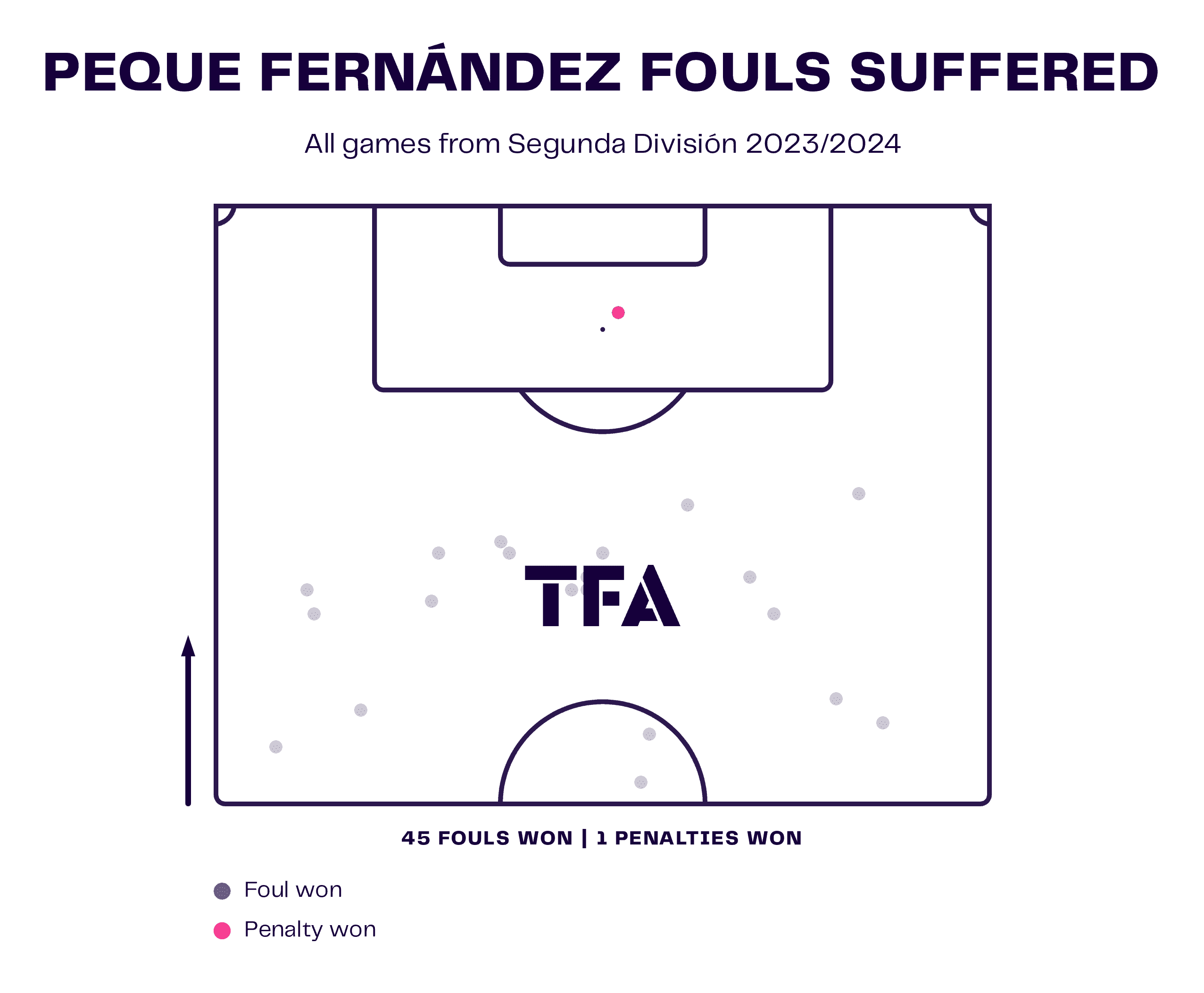
This is not a weakness in itself but an area to work on. If Peque is able to draw more fouls closer to the area, these will add another dimension to Racing’s already impressive attack.
Another such area involves his control of the ball. As seen in some of the examples above, Peque possesses a more than decent touch. However, he still averages 3.23 miscontrols (45th percentile) and is dispossessed 1.65 times (23rd percentile), both per 90. For a player who only receives a little over 30 passes per game, these could result in a turnover of possession several times during a game.
Conclusion
Peque Fernández is one of Spanish football’s latest talents, and his La Masia education is visible in many facets of his constantly improving game. He has used his final-third positioning and shooting ability exceptionally well so far this season, while his passing and dribbling, while in need of improvement, are developing at an admirable rate. To top it all off, he has also proven to be a superb penalty-taker for Racing this term.
The Segunda Division’s top-scorer is one to monitor for the rest of the season, especially considering that he will enter the final year of his Racing contract next summer.





Comments